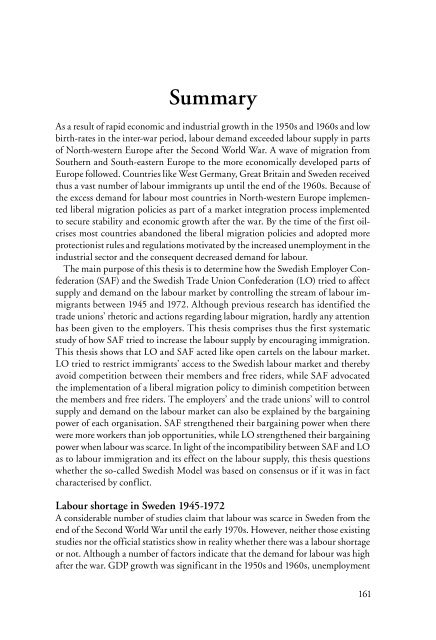gupea_2077_29098_3
gupea_2077_29098_3
gupea_2077_29098_3
Create successful ePaper yourself
Turn your PDF publications into a flip-book with our unique Google optimized e-Paper software.
Summary<br />
As a result of rapid economic and industrial growth in the 1950s and 1960s and low<br />
birth-rates in the inter-war period, labour demand exceeded labour supply in parts<br />
of North-western Europe after the Second World War. A wave of migration from<br />
Southern and South-eastern Europe to the more economically developed parts of<br />
Europe followed. Countries like West Germany, Great Britain and Sweden received<br />
thus a vast number of labour immigrants up until the end of the 1960s. Because of<br />
the excess demand for labour most countries in North-western Europe implemented<br />
liberal migration policies as part of a market integration process implemented<br />
to secure stability and economic growth after the war. By the time of the first oilcrises<br />
most countries abandoned the liberal migration policies and adopted more<br />
protectionist rules and regulations motivated by the increased unemployment in the<br />
industrial sector and the consequent decreased demand for labour.<br />
The main purpose of this thesis is to determine how the Swedish Employer Confederation<br />
(SAF) and the Swedish Trade Union Confederation (LO) tried to affect<br />
supply and demand on the labour market by controlling the stream of labour immigrants<br />
between 1945 and 1972. Although previous research has identified the<br />
trade unions’ rhetoric and actions regarding labour migration, hardly any attention<br />
has been given to the employers. This thesis comprises thus the first systematic<br />
study of how SAF tried to increase the labour supply by encouraging immigration.<br />
This thesis shows that LO and SAF acted like open cartels on the labour market.<br />
LO tried to restrict immigrants’ access to the Swedish labour market and thereby<br />
avoid competition between their members and free riders, while SAF advocated<br />
the implementation of a liberal migration policy to diminish competition between<br />
the members and free riders. The employers’ and the trade unions’ will to control<br />
supply and demand on the labour market can also be explained by the bargaining<br />
power of each organisation. SAF strengthened their bargaining power when there<br />
were more workers than job opportunities, while LO strengthened their bargaining<br />
power when labour was scarce. In light of the incompatibility between SAF and LO<br />
as to labour immigration and its effect on the labour supply, this thesis questions<br />
whether the so-called Swedish Model was based on consensus or if it was in fact<br />
characterised by conflict.<br />
Labour shortage in Sweden 1945-1972<br />
A considerable number of studies claim that labour was scarce in Sweden from the<br />
end of the Second World War until the early 1970s. However, neither those existing<br />
studies nor the official statistics show in reality whether there was a labour shortage<br />
or not. Although a number of factors indicate that the demand for labour was high<br />
after the war. GDP growth was significant in the 1950s and 1960s, unemployment<br />
161


